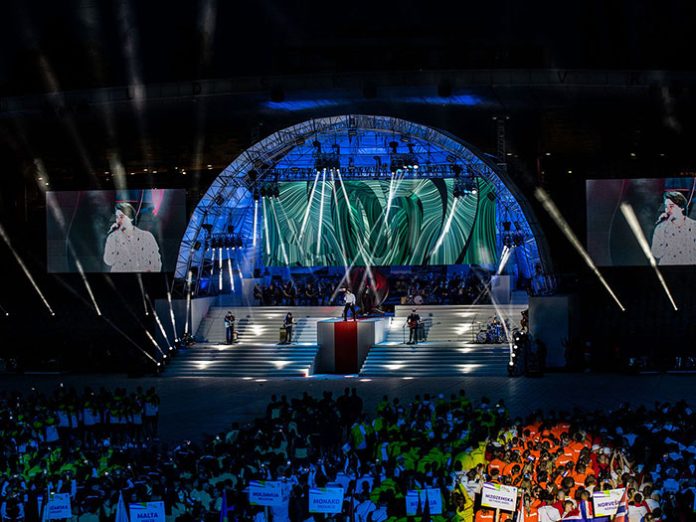Lighting Designer, Crt Birsa of Blackout was asked to be part of a team creating an opening ceremony in Ljudski Vrt football stadium by Show Director, Nejc Levstik – a project on which he worked closely with Set Designer, Greta Godnič featuring nearly 200 Robe moving lights.
“I was extremely proud to be asked onboard,” commented Birsa. “It is always interesting and exciting working with Greta and Nejc, and everyone involved wanted to deliver an outstanding show fitting to the occasion!”
To ensure all lighting bases were covered, Birsa included 10 FORTES, 70 Spiiders, 16 Pointes, 36 MegaPointes, 32 LEDBeam350s and 20 Tetra2s for the rig, which were supplied by Ljubljana-based Event Lighting.
It is the second largest stadium in Slovenia and some of the throw distances were well over 100 metres. “It might sound like stating the obvious,” said Birsa, “but for a stadium show you need to make sure you can fill the space so you need lots of lights ideally on different levels that can be mixed and matched to give those high impact effects!”
Nejc came up with a general concept which involved accommodating an orchestra, while Godnič thought about what would work structurally and architecturally in the space for which the sacred grass had to be covered for protection with a major football match due shortly after the OC. Godnič floated the idea of having a dome-shaped stage recessed as much as possible into the seating tribune, to keep it off the grass, which would also merge well with the curvature of the stadium roof.
Birsa positioned 16 Pointes along the left and right tribunes on either side of the stage, which was installed along one of the long sides of the venue, partly built over the bleacher seating as per the original suggestion from Greta.
10 MegaPointes were deployed stage left and right sides of the front set of stairs coming off the stage and down onto the pitch, with the other 26 MegaPointes rigged on six upstage / downstage orientated ‘finger’ trusses fitted to its domed shape.
“They were small enough not to impose on sightlines, and they are nice and bright, so the ideal fixture to have in these positions and also not encroach on the upstage LED screen,” noted Birsa.
The 10 FORTES were located on the opposite side of the stadium on the highest tribune balconies, and utilised for front lighting. Four traditional follow spots were also located in the same positions.
These FORTES were all used as key lighting for all performers on the stage and all the action on the pitch in front of it, an area also covered with 54 of the 70 Spiiders. The FORTES “really surprised me,” said Birsa, explaining that he’d used them before but only in smaller venues. “I knew they were a great light with an excellent quality of output, but I was very impressed with the brightness and clarity over a serious distance like that!”
The 54 Spiiders were run out along the side of stage tribunes and on the opposite balcony side walls – the same place as the FORTES: The other 16 Spiiders were deployed onstage, on the central four finger trusses.
Of 32 LEDBeam 350s on the rig, six were used for covering the orchestra elements sitting behind the LED screen, with 12 on the lowest finger trusses each side where they were handy for low level side fill. Another two were tucked into the edges of the dome stage for lower side light, plus six a side on the front stairs complementing the MegaPointes also working as side washes. Their small beams were also used to augment the show scenes.
The lighting control set-up featured two ChamSys consoles – one for show lighting and one for audience, key, and white lighting, which facilitated sharing of the LEDBeam 350s between the show lighting and key lighting groups of fixtures. Working with Birsa on programming and running lighting was his colleague Klemen Krajnc from Blackout.
Twenty Tetra2s kit were positioned on the floor around the upstage sections of the stage at two metre intervals and used to graze up and colour the skins of the dome. Birsa selected Robe for this event because they were “bright, multifunctional and reliable giving me plenty of creative latitude and enabling us to programme quickly.”
The event’s main producer was Mitja Špes, the technical director was Rok Ložar and the striking LED content designer was Den Baruca. Birsa concluded: “Challenges included summer storms and losing about 5 hours of work daily at the site as a result, but excellent teamwork enabled us to achieve great results and deliver the ceremony without any setbacks.”






